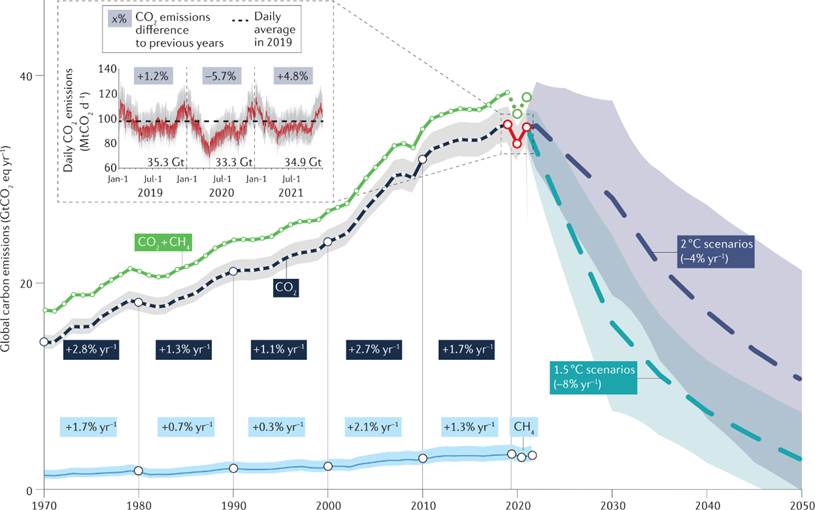According to the latest assessment report of the Intergovernmental Panel on Climate Change (IPCC), to realize the goal set by Paris Agreement for limiting a global warming to 1.5°C and 2°C by 2100, starting from 2020, the global carbon budget for 1.5 °C and 2 °C warming is estimated to be 400 GtCO2 and 1,150 GtCO2 with 67% likelihood. Liu Zhu's Research Group of the Department of Earth Science System (DESS), Tsinghua University uses the global near-real-time carbon monitor database (Carbon Monitor) to realize near-real-time monitoring of global carbon emissions and update the latest global remaining carbon budget. The latest data show that global CO2 emissions rebounded by 4.8% in 2021, reaching 34.9 GtCO2. These 2021 emissions consumed 8.7% of the remaining carbon budget for limiting anthropogenic warming to 1.5 °C or 3% of the remaining budget for limiting anthropogenic warming to 2 °C, which if current trajectories continue, might be used up in 9.5 years and 31 years respectively.
These research results have been recently published in Nature Reviews: Earth & Environment in the form of a paper titled “Monitoring Global Carbon Emissions in 2021”. The paper published the latest changes of global carbon emissions in 2021 based on global near-real-time carbon data, and updated the global carbon budget under the global warming goal of the Paris Agreement.
The article points out that global carbon emissions dropped substantially in 2020 (-5.7%), but rebounded in 2021. Similar to CO2, fossil-related methane emissions dropped by 5.7% from 2019 to 2020, but then rebounded by 3.7% in 2021. Though major countries have announced their respective carbon neutrality goals, near-real-time data demonstrate that current global emission reduction extent and measures are a far cry from the goals in the Paris Agreement. More aggressive emission reduction actions are therefore called for and countries should strengthen continuous monitoring, documentation and evaluation of national carbon emissions.
Associate Professor Liu Zhu of DESS, Tsinghua University, is the first author and corresponding author of the article. The co-authors include Deng Zhu, a 2019 doctoral candidate from DESS, Tsinghua University, Professor Steven J. Davis from the University of California, Irvine, Clement Giron from Kayrros, France, and Professor Philippe Ciais from Laboratoire des Sciences du Climat et de l’Environnement LSCE, Gif-sur-Yvette, France.
Written by Deng Zhu and Liu Zhu
Edited by Wang Jiayin
Reviewed by Zhang Qiang
Article link: https://doi.org/10.1038/s43017-022-00285-w
Related information:
[1] Global near-real-time carbon monitor database: https://carbonmonitor.org/
[2] Liu, Z., Ciais, P., Deng, Z., Lei, R., Davis, S.J., Feng, S., Zheng, B., Cui, D., Dou, X., Zhu, B., Guo, R., Ke, P., Sun, T., Lu, C., He, P., Wang, Y., Yue, X., Wang, Y., Lei, Y., Zhou, H., Cai, Z., Wu, Y., Guo, R., Han, T., Xue, J., Boucher, O., Boucher, E., Chevallier, F., Tanaka, K., Wei, Y., Zhong, H., Kang, C., Zhang, N., Chen, B., Xi, F., Liu, M., Bréon, F.-M., Lu, Y., Zhang, Q., Guan, D., Gong, P., Kammen, D.M., He, K., Schellnhuber, H.J., 2020. Near-real-time monitoring of global CO2 emissions reveals the effects of the COVID-19 pandemic. Nature Communications 11, 5172.
[3] Liu, Z., Ciais, P., Deng, Z., Davis, S.J., Zheng, B., Wang, Y., Cui, D., Zhu, B., Dou, X., Ke, P., Sun, T., Guo, R., Zhong, H., Boucher, O., Bréon, F.-M., Lu, C., Guo, R., Xue, J., Boucher, E., Tanaka, K., Chevallier, F., 2020. Carbon Monitor, a near-real-time daily dataset of global CO2 emission from fossil fuel and cement production. Scientific Data 7, 392.

Fig. 1 Global CO2 and CH4 emission trends